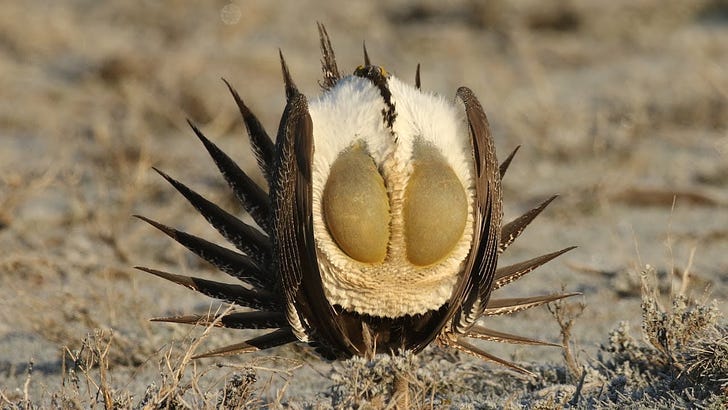Onshore Wind Development Could Impact Sage Grouse Populations
Will environmentalists sacrifice sage grouse at the alter of net-zero?
While oil and gas development is traditionally blamed for the greater sage-grouse’s plight, a new study claims clean energy development poses the same—if not greater—threat to them.
The Wildlife Society published the first-of-its-kind study examining the impact of onshore wind development on sage grouse breeding habits, with respect to wind farm disruption of breeding grounds known as leks. It studied the relationship between male grouse lek attendance and wind farms in three ways: “distance of the leks from turbines, density of the turbines and distribution of the turbines.”
A topline finding was this: the higher the wind turbine density, the more likely some male sage grouse abandoned their leks.
“There were three leks where the distribution [of turbines] was really concentrated close by. They all became inactive. All the birds quit attending those leks,” Dr. Jeffrey Beck, a University of Wyoming researcher and co-author of the study, told Oil City News.
With respect to female sage grouse breeding habits, the study also found:
There is evidence that wind energy development is avoided by females during brood-rearing and summer periods and is associated with lower nest and brood survival up to 2 years following development.
The study concluded, “Direct habitat removal and fragmentation resulting from any form of energy development is unlikely to benefit sage-grouse populations.”
Clean energy projects, including wind and solar, are receiving scrutiny for their potential adverse impacts on wildlife—including the sage grouse.
There are about 800,000 sage grouse remaining, spanning South Dakota to Western states. For populations to be maintained and thrive, the U.S. Fish and Wildlife Service (USFWS) says habitat must have 25% sagebrush cover to thrive and have sufficient breeding grounds (leks). Catalyzing onshore wind—a Biden-Harris administration priority—could adversely affect this population, yet environmentalists remain silent here.
Even the popular Paramount Network show, Yellowstone, explored how sage grouse habitat would be negatively impacted by solar development during the fourth episode of Season 5. The memorable exchange between Kevin Coster’s character, John Dutton, and one of his advisors went like this:
Stanley: There’s empirical evidence that gas exploration and extraction have a negative impact on the sage grouse environment.
John Dutton: And what effect you think 7,000 acres of solar panels are going to have on their environment?
Stanley: There’s no evidence that solar panels would have any impact on the sage grouse environment.
John Dutton: What do they do with the sagebrush when they put in the solar panels?
Stanley: They, they, they would clear it before putting in the solar panels.
John Dutton: And remove the sagebrush?
Stanley: Yes sir.
John Dutton: Sage Grouse live in the sagebrush.
Stanley: They do.
There are massive concerns with aggressively deploying onshore wind beyond its potential adverse impact on wildlife. It’s equally land intensive, unreliable, and costly despite being backed by government subsidies.
Compared to nuclear facilities that use roughly one square mile of land for a 1,000 megawatt facility, wind farms require 360 times more land to generate an equivalent amount of electricity.
Onshore wind only averages a 35% capacity factor (or energy source’s efficiency)—meaning it’s only reliable, at best, for about 35% of the year.
As I noted here at IWF, U.S. wind generation has decreased despite billions in government subsidies:
A new Energy Information Administration (EIA) report revealed U.S. wind energy generation (onshore and offshore) decreased by 2.1% in 2023, despite the sector adding 6.2 gigawatts of new capacity power. This is the first decrease reported since the 1990s.
…
Between 2004 and 2022, the private sector and federal government cumulatively invested over $300 billion for a measly 150 gigawatts of wind energy capacity. But no amount of Inflation Reduction Act money or supposedly good public relations can salvage wind’s image.
More troubling is this “cheap” energy source is getting more expensive, too. A June 2024 Lazard Levelized Cost of Energy+ (LCOE) report found wind build-out is more expensive and found standalone utility-scale onshore wind spiked from $38/Megawatt Hours (MWh) in 2021 to $50/MWh in 2024.
Wind farm construction can result in habitat loss and degradation, breeding habit disruption, and harm to endangered species. But there’s virtual silence from environmental groups who have bought into renewables.
As more research on clean energy projects is conducted, trade offs to their construction and deployment should be weighed—not dismissed.
Learn more about wind energy HERE.
What do you think? Tell me below!
-Gabriella




Eye-opening discussion of the plight of the sage grouse -- and the radio silence from the so-called environmentalist NGOs says it all!